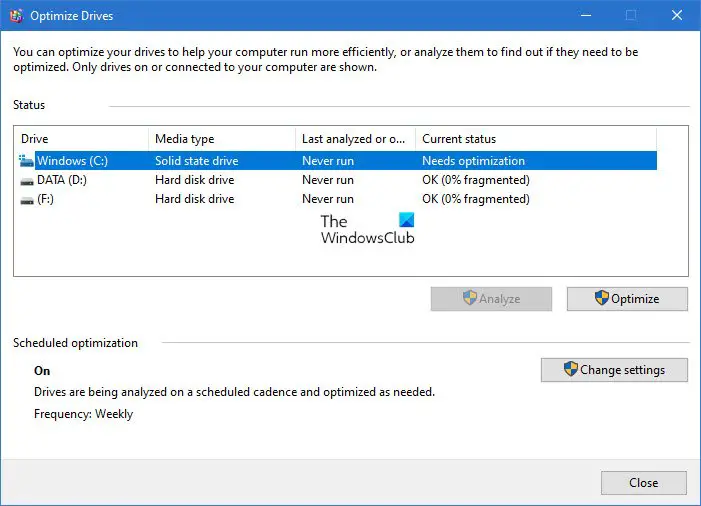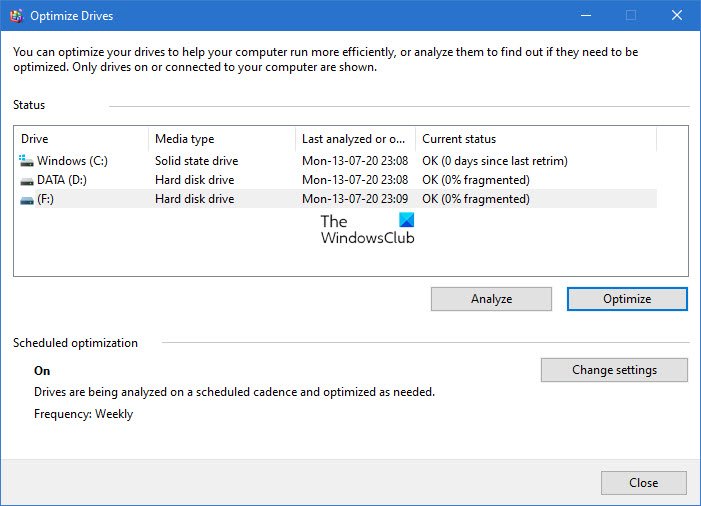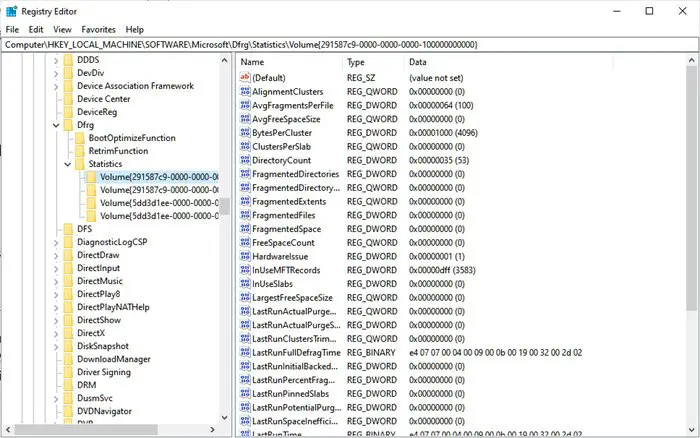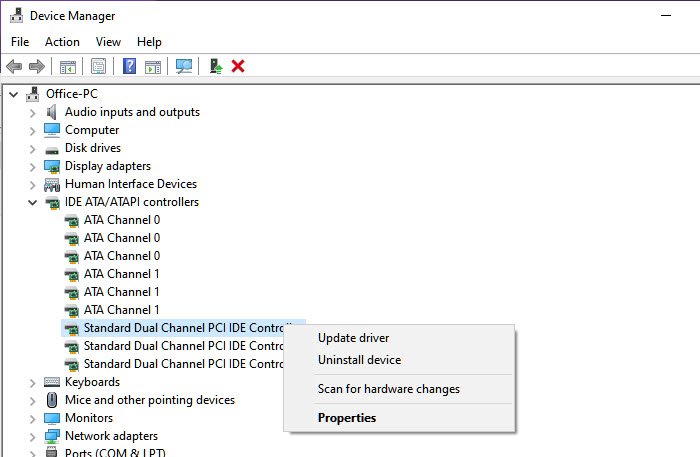Windows offers disk optimization tools that can help you speed up system performance. In fact, a lot of this is automated and can be scheduled as well. That said when you open the Disk Defragmenter or Optimize Drives tool and notice that Optimization is not available or it shows Never Run in Windows 11/10, here’s what you can do about it.

Optimize Drives shows Never Run or Optimization not available
When you notice the last analyzed and current status, you should see Last analyzed on or run may show “Never run” and Current status may show “Optimization not available.” Along with this, if you notice the media type of the driver carrying the status, it could display Unknown. This could also be why Optimization is not available, notably if the Drive is encrypted. However, we see reports in forums where users with SSDs and drives with no encryption face the same problem.
Users of Windows 10 v2004 have been noticing this issue, and Microsoft is expected to fix this soon. Meanwhile, here are a few things you could try to fix this problem:
- Click on the Optimize button
- Defrag from Command Line
- Third Part Defragger Tool
- Delete Defrags’s Stats Keys from Registry
- Remove the IDE ATA/ATAPI controllers driver in Safe Mode
Before we go ahead, if the button is available, you may try to run it, but chances are it will not work. Some users have also reported that the status changes back to Optimization not available after a restart is complete.
1] Click on the Optimize button

First the very basic. Click on the Optimize button to run the defragmentation manually and see if makes the message go away.
2] Defrag from Command Line
Press the Start Menu, and type cmd. When the Command Prompt appears, right-click on it, and click on Run as Administrator from the context menu. Execute defrag command with /A switch to perform analysis for the specific volume
defrag c: /a
Depending on the analysis, if the result suggests defragmenting, then you can run the defrag command with /U /V switch for HDDs and /L /O switch for SSDs. The latter will run the trim command after the operation completes. You can also use the /X switch to consolidate free disk space on the volumes you specify.
defrag c: /U /V
If you can run the defragment tools from the command line, but not the user interface, then it could be a bug that is making it unavailable. A cumulative update will likely fix it, but until then, you can use the command line option. Once you run the commands, you should see the changes once the process is complete.
3] Third-party Defragger Tool
You can use third-party defragment tools like UltraDefrag, MyDefrag, Piriform Defraggler, Auslogics Disk Defrag, Puran Defrag Free, and more to perform analysis and defragmentation of the drives. If it’s an SSD, make sure to read out the guide if you should be performing any sort of performance analysis on it. Until the Optimize Drive Tool shows Never Run or you cannot run it, there are several alternative methods and tools you can use to maintain your drives and keep them performing efficiently.
4] Delete Defrags’s Stats Keys from Registry

You can use this fix if the issue appears after an OS upgrade or driver upgrade. It will force the OS to recreate the keys with new information. Make sure to create a system restore point as we are about to edit the registry.
Type regedit in the Run prompt (Win +R) and press the Enter key to open the Registry editor.
Navigate to:
HKEY_LOCAL_MACHINE\SOFTWARE\Microsoft\Dfrg\Statistics
Delete all subkeys under Statistics
Reboot your PC and open the Windows defragment tool. You should now have the Optimize button enabled.
As you can see in the above screenshot image, each of the drives I have on the PC is listed here.
The details include LastRunTime, MovableFiles, MFTSize, and other crucial details for defragmentation. When you delete the keys, Windows recreates all this as a fresh start, which should make the optimization option available.
5] Remove the IDE ATA/ATAPI controllers driver in Safe Mode

Drivers are known to cause all sorts of misconfiguration, which could be why a media type is displayed as Unknown. To resolve this, we will have to remove the controllers and reboot.
Boot into Safe Mode by pressing the Shift and then click on the Restart option in the menu. It will reboot the computer into Advanced Startup Options. Select Safe mode from the option.
Once in the Safe Mode, open Device Manager using WIN + X, followed by the M key. Expand the IDE ATA/ATAPI controllers. Right-click on each of the listings, and uninstall the device. Reboot the computer, and Windows will automatically install the drivers.
Now, if you try, the optimize button should be available.
Should you remove SSDs from the defragmentation schedule?
The issue can also cause one more problem. Since it keeps forgetting when was the drives optimized, it will repeat the trimming and defrag on SSD drives, which is not good. It would be an excellent idea to uncheck the drives from the Automatic Maintenance feature.
- In the Start menu, type ‘defragment’, and then click on the Optimize Drives tool when it appears.
- Click on the Change Settings button and then click on the Choose button next to Drive.
- Uncheck all SSD drives from the list. If there is a hidden partition that is a part of SSD drive, uncheck that too.
- Save, and the SSD drives will not be optimized anymore.
In fact, you don’t need to optimize the SSD drive at all if you have enabled the Trim feature and using OEMs software to manage it.
I hope the post was easy to follow, and you could optimize the Drive even though the Optimization button was not available in Windows 11/10.
How do I enable Optimize Drives for defrag?
Optimize Drives is enabled (by default) in Windows 10 /11 during the initial setup of the operating system. To confirm that Optimize Drives is enabled and running on your system, type ‘defragment’ in the Windows Search bar and select Defragment and Optimize Drives. You’ll see your drive list and their optimization status in the Optimize Drives window. Click the Change Settings button. The check mark against the ‘Run on a schedule (recommended)’ option indicates that the system is set to automatically optimize your drives on a regular basis.
What is the difference between defrag and optimize?
Defragmentation (or Defrag) is a process specifically designed to improve the performance of Hard Disk Drives by reorganizing fragmented data, while Optimization is a broader term used to maintain overall drive performance and efficiency in both Hard Disk Drives and Solid State Drives. The Optimize Drives utility in Windows combines these processes into a unified tool that automatically determines the best approach for drive optimization based on its type.
Read Next: Enable or Disable Defragmentation for SSD in Windows.
Leave a Reply